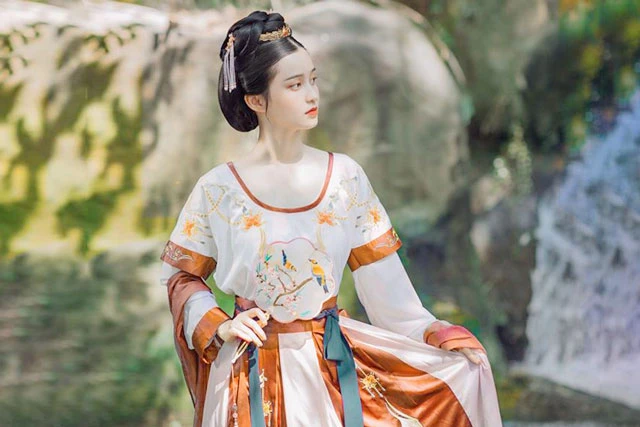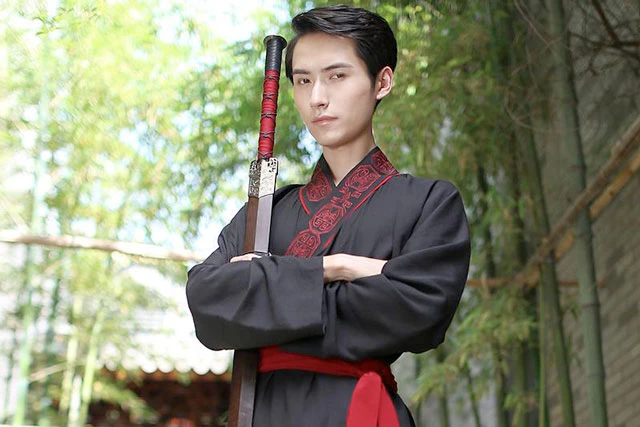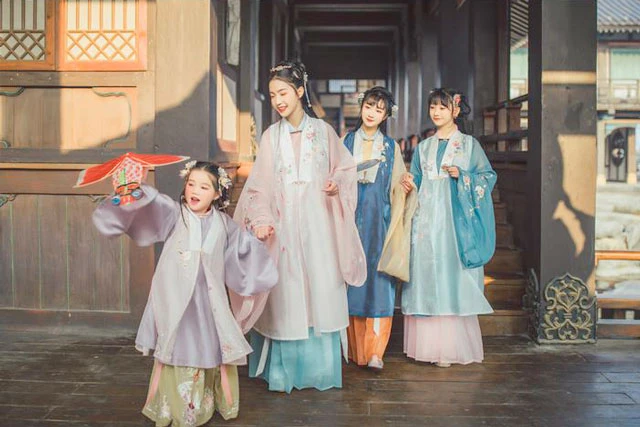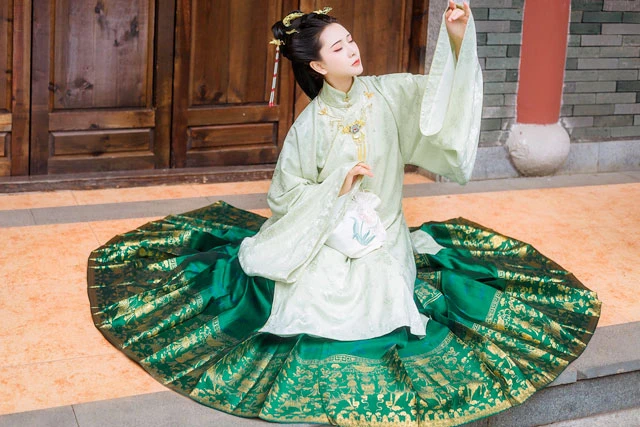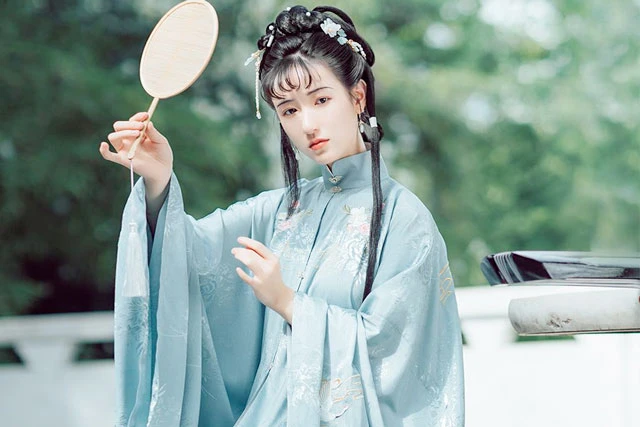Traditional Chinese clothing is one of the world’s most iconic traditional items of costumes. You may also have heard of hanfu dress – it is instantly recognizable, with Overlapped and Rightward Collars, flowing cutting, retro Eastern patterns, diverse colors, and luxurious silk fabric.
But hanfu robe is not the only classical clothing ancient China has in its special repertoire. Here’s a breakdown of the most popular traditional Chinese garments you might be interested in.

30 Most Classic Traditional Chinese Clothing in History
- Yi Shang
- Guanfu
- Shenyi
- Hufu
- Quju
- Kaijia
- Qiyao Ruqun
- Zhiju
- Wei Jin Ruqun
- Qixiong Ruqun
- Yuanlingpao
- Banbi Tangling
- Beizi
- Songku
- Shuhe
- Lanshan
- Bijia
- Yesa
- Aoqun
- Mamianqun
- Liling
- Daopao
- Feiyufu
- Paofu
- Magua
- Qipao
- Samfu
- Changshan
- Zhongshan Zhuang
- Tang Suit
Luckily, creating a read-worthy brief history list about Chinese traditional clothing isn’t too hard. In fact, you don’t need to look any further than the boring archaeology book. If you don’t know the difference between hanfu clothing and qipao dress, then don’t worry, this is a great place to begin.
# Shang Dynasty – 1600 B.C.
Shang Dynasty is an important stage in which the Chinese Han went into its maturation. By the Shang period, these symbols had become a well ﹣ developed writing system.
1. Yi Shang
Yi means top hanfu shirt or robe, Shang means bottom hanfu skirt, Yishang is the earliest historically recorded traditional Chinese clothing in history. In this period, with the emerge of silk technology, normal clothing actually came into the public’s lives.
# Zhou Dynasty – 1000 B.C.
In the Zhou Dynasty, it revealed more humanistic spirit when Humanism was awakened. The traditional costume design of this period has been greatly modified compared to the previous times.
2. Guanfu
The Zhou‘s clothing generally followed the Shang Dynasty clothing system but with slight changes. The style of clothes was becoming looser than before. The Zhou dynasty was famous for its emphasis on etiquette, so there were stricter requirements for the pattern of clothes, and from this time wide & loose became a typical feature of traditional Chinese clothing.
# The Spring and Autumn Period – 770 B.C.
Social turbulences during the Spring and Autumn Period resulted in many conceptual changes. People began to venture into all kinds of new things and design ideas, and traditional Chinese clothing appeared to be diversified.
3. Shenyi
Following the advancement of printing and dying technologies, it gave clothing the values of art. More colorful and new style clothes Started to become popular, the top one is called Shenyi dress. It sewed Yi and Shang together, then the one-piece traditional hanfu was highly sought after.
4. Hufu
The Hu Fu was originally a traditional Chinese clothing of Hu ethnic, quite different from the loose traditional clothing, featuring a tight jacket and narrow pants, and a belt hook to facilitate riding and shooting activities. Because the Hu Fu was light and practical, it soon spread to the folk.
# Qin Dynasty – 220 B.C.
Qin Dynasty in Chinese history is the first united centralized feudal state. although it is of short duration, it holds an important position in the development of Chinese history. Starting from the Qin Dynasty, China began to establish standard regulations, such as promoting the use of the same character and language in the whole country and making norms for traditional Chinese clothing as well.
5. Quju
The Quju is a kind of shenyi clothing, but the wearing method is different. The width of the Quju is more than 3 meters when it is unfolded, and needs to be wrapped many times around the waist when wearing, so it is also called a three-layer robe. Quju can be worn by both men and women, and it was once very popular in ancient China for a very long time.
6. Kaijia
Before the establishment of the Qin Dynasty, this mainland went through countless wars and the armor was fully developed in this period. Through the Emperor Qin’s Terra Cotta Warriors, it can be felt that the Kaijia (soldier’s armor) of this era was not only a piece of clothing but also a work of art.
# Han Dynasty – 200 B.C.
Throughout more than thousand years of development, traditional Chinese clothing has reached a very mature stage. From the Han Dynasty, people began to establish a real clothing system, and the costume of this old civilization finally got its official name, Hanfu. The cross collar, right overlapping, and use ties to bind the clothes (no buttons) have also become the most classic features of Hanfu.
7. Qiyao Ruqun
Ru is a short & thin top shirt, and Qun is a bottom skirt. Qiyao Ruqun is a kind of two-piece hanfu clothing. In the early Han Dynasty, Qiyao hanfu- the skirt is tied at the waist or high-waisted, is a new fashion choice for women. This wearing style gave birth to a famous hanfu pattern called Liuxianqun (which means the dress of a fairy or goddess).
Besides, makeup cosmetics, hanfu accessories, and embroidery cloth shoes also breakout in this era, people can try more dress-up ways to make themselves look more beautiful.
8. Zhiju
The Zhiju dress is another classic style of shenyi clothing. The Zhiju train was invented long ago, but it did not widely accept until the Han Dynasty.
The biggest difference between the Zhiju and the Quju is that its bottom is vertical cutting and does not need to be wrapped around the body in many layers, so it’ll be more convenient for daily life. And you can see them in the TV series or films of the Three Kingdoms,
# Wei, Jin, Southern & Northern Dynasty – 220 A.D.
It was a time of chaos when more than 30 different dynasties were established and destroyed in a brief 300-year history. Traditional Chinese clothing underwent an unprecedented convergence during this tumultuous period.
Clothing styles from various remote regions and ethnic groups influenced each other, while thanks to the Silk Road, fine Persian patterns and pigments entered China at this time. All of these excellent elements were absorbed and improved upon by the Hanfu.
9. Wei & Jin Ruqun
The Wei & Jin styles of traditional Chinese clothing had a great influence on the creation of martial arts today. Instead of small & short shirt design, the Ru began to used wide & long sleeves similar to Shen Yi’s robe. The overall style was very flowing, casual and nowadays most wuxia clothes are designed based on this style.
# Tang Dynasty – 620 A.D.
With vast territory, stable council, developed economies and prosperous cultures, the prophase of the Tang Dynasty reached a peak through the development of the ancient society, during which the Golden Years, Kaiyuan Spirit are always admired by the posterity.
The Change and Influence of the Open Pattern, Calligraphy, painting, and sculpture flourished. Poetry was blooming in this period also represent the highest achievement of ancient poems. The most important, silk embroidery was entirely developed in the Tang dynasty.
10. Qixiong Ruqun
In contrast to the Qiyao Ruqun, the skirt of the Qixiong is much longer and is tied (fixed) at the chest. And the upper Ru is much shorter, very close to today’s crop tops. The flounced jacket was very prevalent among the ladies of the Tang Dynasty, and many ancient paintings and excavated artifacts preserved today have traces of it.
11. Yuanlingpao
Yuanlingpao, or Round-necked hanfu robe, appeared as early as the Han Dynasty, but at that time were mainly worn as underwear. Later, after hundreds of years of development, in the Tang Dynasty, the Yuanlingpao robe ushered in explosive growth and served as the main traditional Chinese clothing style for men.
Not only that, it was also recognized as one of the official uniforms, and even in the after Song and Ming dynasties, it became the only grade uniform for the government.
12. Banbi Tanling
The Banbi (half or short sleeve) & Tanling (open-collar) was like a modern t-shirt, but without buttons. It was first popular in the court, and later spread to the citizens, and this trend quickly spread to various towns.
Due to the free and open cultural atmosphere, baring the arms and collar was widely accepted in the big cities, and because dancing was a popular activity in the Tang Dynasty, it was often used as a performance costume.
# Song Dynasty – 960 A.D.
The Song Dynasty was a time in Chinese history when the commodity economy, culture and education, and scientific innovation were all highly prosperous. During this period, Confucianism was revived, science and technology developed rapidly, politics was enlightened, and the people lived in peace and prosperity.
The Song Dynasty was rich in goods, so the development of clothes emerged with a casual-based design style.
13. Beizi
Beizi is a kind of long shirt between the Ru and robe, with slits on both sides and knee-length, usually made of silk, light and see-through. The gown was established as a woman’s formal dress in the Song Dynasty, princesses, noble ladies would also use it as a daily dress.
14. Songku
Qun (skirt) had an important influence in ancient China and lasted for thousands of years. Until the Song Dynasty, pants became popular.
Ku means pants, Songku represents the pants of the Song Dynasty, enough to see that pants were widely accepted in this era. Songku pants usually had two layers, with the outer layer slit on both sides, and it was very loose, similar to modern wide-legged trousers.
15. Shuhe
Shuhe (or Duanda) is made of linen and cotton, much rougher than other hanfu styles. a fitting working garment that was worn more frequently by men. Shuhe’s top is a slim Ru with narrow cuffs to facilitate hand movement, and bottom pants also very tightly wrapped and tied with a cloth belt. This style is used a lot in martial arts, kung fu movies.
16. Lanshan
The Lanshan is similar in appearance to a Yuanlingpao (round-necked robe), with the biggest difference being that its collar edge is vertical and extends to the bottom. In the early Song Dynasty, the Lanshan was mainly used as a uniform for students, teachers, and officials, and later spread to the whole society as a casual hanfu for females as it was easy to wear.
# Yuan Dynasty – 1270 A.D.
The Yuan dynasty was very open-minded. Although the emperor was a Mongol, he respected the cultures of different regions, recognized and promoted almost all kinds of customs and thoughts.
During this period, the cultures of various ethnic groups influenced and learned from each other. It is worth mentioning that Yuanqu (Yuan-style music) was formed in this period, and eventually became one of the great literary heritage of ancient China.
17. Bijia
The Bijia is a horse riding shirt originally from the Mongolian. By the Yuan Dynasty, it became a relatively casual jacket/vest by improving the design with no sleeves, no collar. Initially, it was a leisure wear for men, but later as the use of silk increased, it became very light and thin, more suitable for women to wear. Finally, it turned out to be a kind of ladies’ casual top.
18. Yesa
Yesa (or Zhisunfu) was originally a military uniform. During the Yuan dynasty, it was improved with elements of the Hanfu, and used the classic right overlap design. It was not only the outfit of the royal and officials but also identified as the formal dress.
# Ming Dynasty – 1360 A.D.
The culture of the Ming Dynasty developed rapidly, especially in literature and painting. These two aspects of development in turn had a significant impact on traditional Chinese clothing innovation.
19. Aoqun
Ao, is a kind of coat, usually has two or more layers, and the inner layer uses warm fabric and is usually worn in the winter season. The pattern of Ao is much like the Qiyao Ruqun’s shirt, but has more designs for protection from the cold, such as the cuffs are small and there are various necklines.
Aoqun is actually a two-piece Hanfu suit, Ao is the topcoat, Qun is the bottom skirt, and in the Ming Dynasty, one of the most popular skirts was called the horse-faced skirt.
20. Mamianqun
Mamianqun (or Horse face skirt), has a great significance in the history of Chinese traditional clothing, as it was the dominant skirt for women for over 500 years and spread throughout almost all regions of China.
The Ma-Mian hanfu skirt has 3 special designs,
- A pleated skirt with a relatively more three-dimensional cutting, unlike the flowing style of Ruqun
- 4 separate skirt pieces sewn together only at the waist
- Using a lot of woven gold stamping techniques, which were rarely used before the Ming Dynasty
21. Liling
The major significance of Liling is that it introduced the button to the Hanfu system for the first time. In the middle of the Ming Dynasty, during the Little Ice Age, the weather was extremely cold, so people designed long thick top and used a high collar, while buttons were starting to used to fasten the clothes in order to protect against the chilly wind.
Later, the weather turned warmer, but the design was retained, while many improved versions were launched. and it became the most popular female Hanfu top in the Ming Dynasty.
22. Daopao
Daopao (Taoist robe) is typical casual wear of men’s hanfu in the Ming Dynasty, from the nobility to the common people all took the Daopao as one of the main dresses for daily wear. Other than that, it is sometimes used as a wedding dress for females.
The main difference between the Daopao and the Yuanlingpao (round-necked robe) is the design of the collar, while the Yuanlingpao is more used in formal occasions and the Taoist robe is casual wear.
23. Feiyufu
Feiyu is an ancient Chinese mythological beast, a flying fish, looks like a dragon, boa. Feiyu-fu (or the flying fish robe) was the exclusive costume of the Jin Yi Wei (royal guards) in the Ming Dynasty, and only warriors who were approved by the emperor were qualified to wear it.
Now, the modern Feiyu costume even uses a variety of totems, which is one of the most handsome and wildly attractive traditional Chinese costumes among the men’s Hanfu.
# Qing Dynasty – 1630 A.D.
The Qing Dynasty saw a dramatic change in traditional Chinese clothing. The ruling class at this time was the Manchu ethnic group, and most hanfu patterns were once banned in order to promote Manchu culture. In this background, the dress patterns were mainly Manchu’s Qi and Pao clothing system, but at the same time, a lot of classic Han costume elements were still used.
24. Paofu
Paofu (or Chang Pao, long robe) in the Qing dynasty were preferred to be embroidered with a variety of colors and patterns in their design. The level of silk embroidery in this period was so advanced that even very complicated patterns could be produced in large quantities, and the most important feature of the robes of this period was that the patterns were more exquisite, while the cut was also slimmer.
If you like watching Chinese dramas of the Qing Dynasty, Paofu is the standard dress for almost all female characters on TV.
25. Magua
The Magua was a short vest/shirt, usually worn outside of the Paofu robe, and its function was very close to the western waistcoat, as a part of the standard attire for men.
At first, it was worn by some gentlemen to participate in their social activities, and then gradually became a kind of formal wear, everyone wore changpao inside and Magua outside to show elegance and politeness.
# 1900s to Now
The 100-year modern history of China is also the history of the convergence of Western and Eastern cultures. This change was particularly evident in clothing design, where traditional Chinese clothing began to use more three-dimensional cutting, and Western patterns and new style garments were created to fit the body shape.
26. Qipao
Qipao (or cheongsam), along with Hanfu, is one of the most famous traditional Chinese costumes, and if Hanfu is a representative of classical, then Qipao is a representative of modern. From the appearance of cheongsam, you can see the fusion of at least three cultural elements, the right overlapping design of Hanfu, the Manchu’s Paofu pattern, and the slim cut of Western-style.
In modern China, when there is a traditional festival, many women would wear a cheongsam dress to celebrate the events, also it is widely used in weddings and parties.
27. Samfu
A samfu is a short, tight-fitting top that you can imagine as the upper part of a cheongsam. Nowadays, you can easily buy a modified version of samfu in women’s clothing mall, people like to wear samfu as a vintage and casual style shirt in daily lives.
28. Changshan
The Changshan (or Changgua, Dagua) was developed from the Paofu robe, mainly changing the loose design of the daopao (Taoist robe) to narrow and thin, and the large collar to a small collar. In appearance, Changshan is pretty like a men’s version of a cheongsam, but with a flat vertical cut, no curves, and a plain color, very simple.
29. Zhongshan Zhuang
The Zhongshan Zhuang (or Zhongshan suit) was designed by Dr. Sun Yat-sen (Sun Zhongshan) on the basis of Western costumes, Japanese student uniform, and traditional Chinese clothing, with a four front-pocket and standing flap lapel garment. Afterward, in memory of Mr. Sun, this costume was called the Zhongshan suit.
Mao Zedong also liked Zhongshanzhuang so much, and there was a modified version called the Mao Suit. Both of these suits are now used as formal garments for men in government.
30. Tang Suit
Tang Suit (or Tang Zhuang), is based on the Chinese traditional Magua vest, adding a stand-up collar and Western-style 3D cutting, designed with vintage totems prints or embroidery, Tang suit already belongs to modern clothing, not a classic traditional Chinese clothing, the shape is almost the same as the modern shirt, the biggest difference is that it still using the cloth knot buttons.
Conclusion
In actual history, there are over hundreds of different styles of traditional Chinese Hanfu, but many of them only appeared at certain brief times and in small regions or were inherited from the classic Hanfu style mentioned above with only minor modifications.
So those that are very similar in appearance or have not been accepted by the public for a long time, we decide not to list them all in this timeline, otherwise, it will become another lengthy wiki manual.
Ancient Chinese clothing reflects the inclusiveness and inheritance of Chinese culture. Every time it goes through a new historical period, it can retain its own unique design, but also learn the advantages of other clothing systems, take the essence and remove the dross, and constantly optimize and update itself, thus developing a large number of styles that are suitable for the public and loved by people.
Traditional Chinese clothing shows a strong vitality, advancing with the times, now more and more hanfu community designers are creating many new fashion Han attires based on traditional elements. and we believe it will bring more surprises to everyone in the new century.













